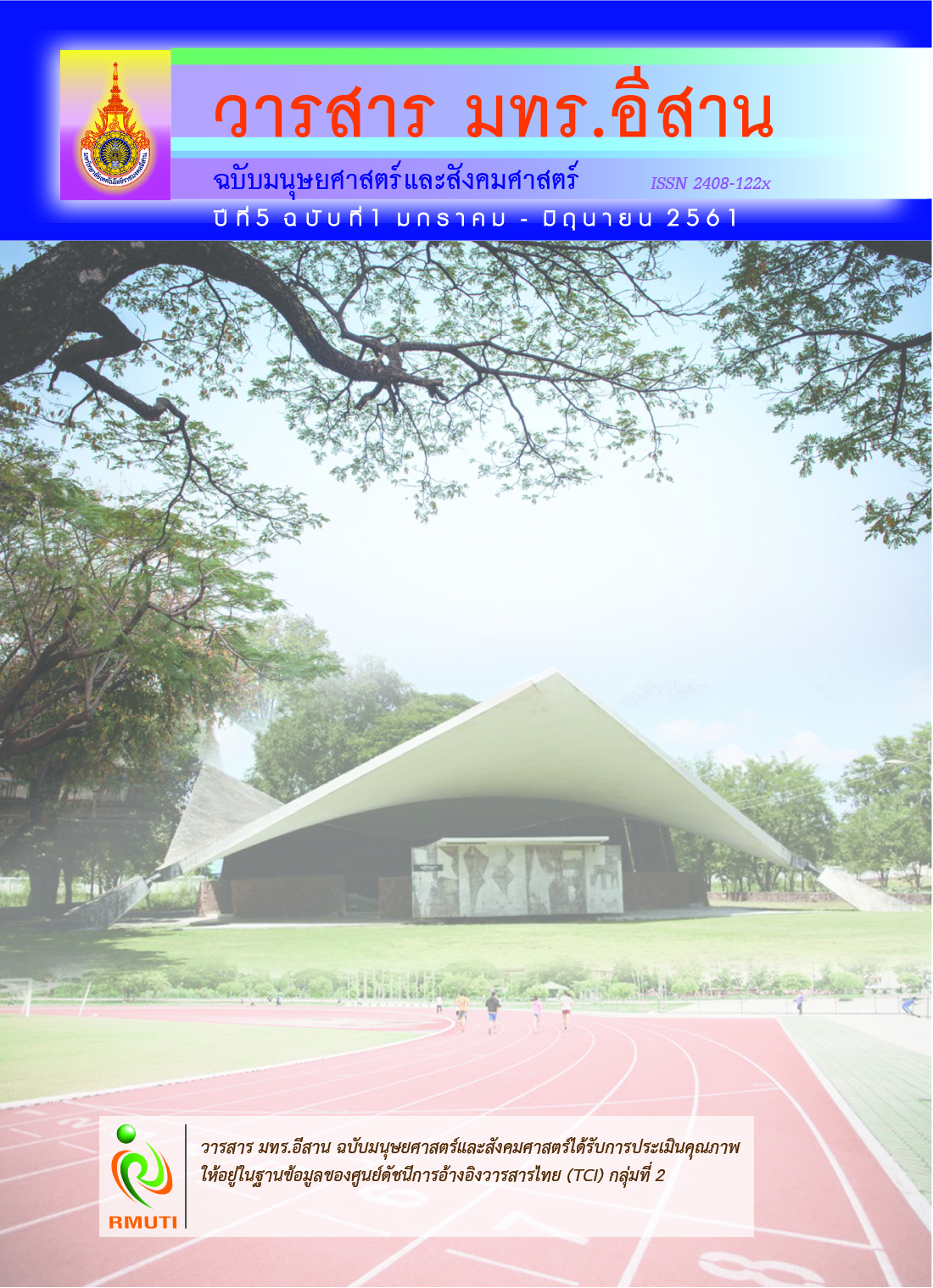The Sustainable Creative Tourism Management: World Heritage Site-Cultural Heritage Alive: a Case Study of Historical Town of Sukhothai and Associated Historic Towns
Main Article Content
Abstract
This objective of this article was analyze the sustainable creative tourism management of World Heritage Site-Cultural Heritage Alive, a Case Study of Historical Town of Sukhothai and Associated Historic Towns by using the concept of creative tourism, development of sustainable tourism, concept of cultural heritage and cultural landscape in order to integrated the management of the World Heritage Site with the context of local intellectual property, ways of life, tradition cultural in the dimension of creative tourism. Creative Tourism is a way of giving tourists the opportunity to develop their creative potential through engaging in learning activities that experience and exchange real experiences as called “Learning - Seeing - Doing” according to the uniqueness of tourist attractions. This will make the tourists learn themselves. Creativity Tourism activities consists of learning the dance of Sukhothai, learning of ceramic of Ban Koh Noi, learning of amulets of Sukhothai, learning of mud cloth of Ban Na Ton Chan, learning of homestay lifestyle of Ban Na Ton Chan and learning of amulets of Nakhonchum. It will enhance to sustainability development of the World Heritage Site-Cultural Heritage Alive: a Case Study of Historical Town of Sukhothai and Associated Historic Towns in sustainability.
Article Details
บทความที่ได้รับการตีพิมพ์เป็นลิขสิทธิ์ของมหาวิทยาลัยเทคโนโลยีราชมงคลอีสาน
ข้อความที่ปรากฏในบทความแต่ละเรื่องในวารสารวิชาการเล่มนี้เป็นความคิดเห็นส่วนตัวของผู้เขียนแต่ละท่านไม่เกี่ยวข้องกับมหาวิทยาลัยเทคโนโลยีราชมงคลอีสานและคณาจารย์ท่านอื่นๆในมหาวิทยาลัยฯ แต่อย่างใด ความรับผิดชอบองค์ประกอบทั้งหมดของบทความแต่ละเรื่องเป็นของผู้เขียนแต่ละท่าน หากมีความผิดพลาดใดๆ ผู้เขียนแต่ละท่านจะรับผิดชอบบทความของตนเองแต่ผู้เดียว
References
กระทรวงวัฒนธรรม. (2555). แหล่งมรดกโลกของไทย. กรุงเทพฯ: กระทรวงวัฒนธรรม
กรมศิลปากร. (2555). นำชมอุทยานประวัติศาสตร์สุโขทัย ศรีสัชนาลัย กำแพงเพชร. กรุงเทพฯ: กรมศิลปากร
จาตุรงค์ โพคะรัตน์ศิริ. (2556). มรดกโลก-มรดกใคร สุโขทัย กับการเปลี่ยนกระบวนวิธีคิดด้านการท่องเที่ยววัฒนธรรม. เข้าถึงเมื่อ (31 มีนาคม 2559). เข้าถึงได้จาก (https://www.etatjournal.com/web/menu-read-web-etatjournal/menu-2014/menu-2014-jan-mar/570-12557-sukhothai)
นาฬิกาอติภัค แสงสนิท. (2555). การสร้างและการธำรงรักษาความยั่งยืนของชุมชนชนบทผ่านการท่องเที่ยวเชิงสร้างสรรค์: กรณีประเทศไทย. องค์การบริหารการพัฒนาพื้นที่พิเศษเพื่อการท่องเที่ยวอย่างยั่งยืน (องค์การมหาชน).
ทินกฤต รุ่งเมือง. (2558). การพัฒนารูปแบบการท่องเที่ยวเชิงสร้างสรรค์เพื่อส่งเสริมเครือข่ายกิจกรรมการท่องเที่ยวของกลุ่มทวารวดี 4 จังหวัด. วารสารร่มพฤกษ์ มหาวิทยาลัยเกริก. ปีที่ 33. ฉบับที่ 1. (มกราคม - เมษายน 2558).
ทิพย์วดี โพธิ์สิทธิพรรณ. (2556). การท่องเที่ยวเชิงสร้างสรรค์เพื่อการท่องเที่ยวอย่างยั่งยืน. วารสารวิชาการ มหาวิทยาลัยฟาร์อีสเทอร์น. ปีที่ 6. ฉบับที่ 2. หน้า 43-48
บุญเลิศ จิตตั้งวัฒนา. (2548). การพัฒนาการท่องเที่ยวแบบยั่งยืน. กรุงเทพฯ: เพรส แอนด์ ดีไซน์
ภัทรพงษ์ อินทร์กำเนิด, พันธุ์อาจ ชัยรัตน์, มุทริกา พฤกษาพงษ์ และธนพนธ์ ตั้งตระกูล. (2553). การท่องเที่ยวเชิงสร้างสรรค์ ในรายงานการวิจัย เรื่อง ระบบนวัตกรรมรายสาขาเพื่อพัฒนาระบบเศรษฐกิจ ฐานความรู้และเชิงสร้างสรรค์: กรณีศึกษา อุตสาหกรรมท่องเที่ยวเชิงสร้างสรรค์.
กรุงเทพฯ : สำนักนโยบายด้านการศึกษามหภาค
ภัยมณี แก้วสง่า และนิศาชล จำนงศรี. (2555). การท่องเที่ยวเชิงสร้างสรรค์: ทางเลือกใหม่ของการท่องเที่ยวไทย. วารสารเทคโนโลยีสุรนารี. ปีที่ 6. ฉบับที่ 1. หน้า 91-109
ยุวดี นิรัตน์ตระกูล. (2556). การท่องเที่ยวเชิงสร้างสรรค์: ต่อยอด เพิ่มค่า หาจุดต่าง. กรุงเทพฯ: กองวิจัยการตลาดการท่องเที่ยวแห่งประเทศไทย
วิวรณ์ สีหนาท. (2546). การศึกษาแนวทางการพัฒนาอาคารเพื่อการอนุรักษ์ชุมชนในพื้นที่ลุ่มคลองกรณีศึกษา คลองอ้อมนนท์และคลองบางกอกน้อยจังหวัดนนทบุรี. วิทยานิพนธ์ ปริญญาการวางแผนภาคและเมืองมหาบัณฑิต มหาบัณฑิต สาขาวิชาการวางแผนชุมชน เมืองและสภาพแวดล้อม บัณฑิตวิทยาลัย สถาบันเทคโนโลยีพระจอมเกล้าเจ้าคุณทหารลาดกระบัง
องค์การบริหารการพัฒนาพื้นที่พิเศษเพื่อการท่องเที่ยวอย่างยั่งยืน (องค์การมหาชน). (2555). โครงการต้นแบบการท่องเที่ยวเชิงสร้างสรรค์. กรุงเทพฯ: องค์การบริหารการพัฒนาพื้นที่พิเศษเพื่อการท่องเที่ยวอย่างยั่งยืน
Feilden and Jokileht. (1998). Management Guidelines for World Cultural Heritage Sites. ICCROM: International Center for the Study of the Preservation and the Restoration of Cultural Property. Access (31 March 2016). Available https://www.dasta.or.th/creativetourism/th/)
ICOMOS. (2004). ICOMOS. International Charters for Conservation and Restoration -Monuments and Sites I. Munich: Lipp GmbH.
Landry, C. (2000). The creative city: A Toolkit for urban innovators. London: Earthscan.
Richards, G. (2011). Creativity and Tourism: the State of the Art. Annals of Tourism Research. Vol. 38. No. 4. pp. 1225-1253
UNESCO. (2001). Universal Declaration on Cultural Diversity. Access (31 March 2016). Available (https://unesdoc.unesco.org/images/0012/001271/127162e.pdf)


